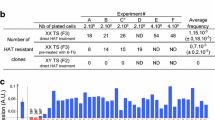Summary
In placenta membranes of newborn girls carrying electrophoretically distinguishable G6PD alleles, the maternally derived isozyme is expressed preferentially. This phenomenon cannot be explained by allelic differences in enzyme activity or by somatic selection directed against cells with particular G6PD phenotypes. Instead, it may be that in this tissue X inactivation is nonrandom. Preferential expression of the maternal X chromosome, as has been shown in marsupials and in extraembryonic membranes of rodents and now in man, may reflect the state of activity of the X chromosomes in the early stages of female embryonic development.
Similar content being viewed by others
References
Adler, D. A., West, J. D., Chapman, Y. M.: Expression of α-galactosidase in preimplantation mouse embryo. Nature 267, 838–839 (1977)
Bender, K., Frank, R., Hitzeroth, H. W.: Glyoxalase I polymorphism in South African Bantuspeaking negroids. Hum. Genet. 38, 223–226 (1977)
Boué, A., Boué, J.: Chromosome abnormalities and abortion. In: Physiology and genetics of reproduction, F. Fuchs, E. M. Coutinho, eds. New York: Plenum Press 1974
Brown, S. W., Chandra, H. S.: Inactivation system of the mammalian X-chromosome. Proc. Natl. Acad. Sci. USA 70, 195–199 (1973)
Chandra, H. S., Brown, S. W.: Chromosome imprinting and the mammalian X-chromosome. Nature 253, 165–168 (1975)
Cohen, M. M., Rattazzi, M. C.: Cytological and biochemical correlation of late X-chromosome replication and gene inactivation in the mule. Proc. Natl. Acad. Sci. USA 68, 544–548 (1971)
Cooper, M. M.: A directed genetic change model for X-chromosome inactivation in eutherian mammals. Nature 231, 292–294 (1971)
Epstein, C. J.: Expression of the mammalian X-chromosome before and after fertilization. Science 175, 1467–1468 (1972)
Fryns, J. P., Kerckhove, A. van de, Goddeeris, P., Berghe, H. van den: Unusually long survival in a case of fall triploidy of maternal origin. Hum. Genet. 38, 147–155 (1977)
Gardner, R. L., Lyon, M. F.: X-chromosome inactivation studied by injection of a single cell into the mouse blastocyst. Nature 231, 385–386 (1971)
Gartler, S. M., Liskay, R. M., Campbell, B. K., Sparkes, R., Grant, N.: Evidence for two functional X-chromosomes in human oocytes. Cell Differ. 1, 215–218 (1972)
Gartler, S. M., Liskay, R. M., Gant, N.: Two functional X-chromosomes in human foetal oocytes. Exp. Cell Res. 82, 464–466 (1973)
Gartler, S. M., Andina, R. J.: Mammalian X-chromosome inactivation. Adv. Hum. Genet. 7, 99–140 (1976)
Giannelli, F., Hamerton, J. L.: Non-random late replication of X-chromosomes in mules and hinnies. Nature 232, 315–319 (1971)
Hamerton, J. L., Richardson, B. J., Gee, P. A., Allen, W. R., Short, R. V.: Non-random X-chromosome expression in female mules and hinnies. Nature 232, 312–315 (1971)
Hitzeroth, H. W., Bender, K., Wolfswinkel, J. M.: Esterase D polymorphism in South African negroids. S. Afr. J. Sci. 72, 301–303 (1976)
Hitzeroth, H. W., Bender, K., Ropers, H. H., Geerthsen, J. M. P.: Tentative evidence for 3–4 haematopoetic stem cells in man. Hum. Genet. 35, 175–183 (1977)
Issa, M., Blank, C. E., Atherton, G. W.: The temporal appearance of sex chromatin and of the late replicating X-chromosome in blastocysts of the domestic rabbit. Cytogenetics 8, 219–237 (1969)
Kaufman, M. H., Guc-Cubrilo, M., Myon, M. F.: X-chromosome inactivation in diploid parthenogenetic mouse embryos. Nature 271, 547–549 (1978)
Lifschytz, E., Lindsley, D. L.: The role of X-chromosome inactivation during spermatogenesis. Proc. Natl. Acad. Sci. USA 69, 182–186 (1972)
Lyon, M. F.: X-chromosome inactivation and developmental patterns in mammals. Biol. Rev. 47, 1–35 (1972)
Martin, G. R., Epstein, C. J., Travis, B., Tucker, G., Yatziv, S., Martin, D. W., Jr., Clift, S., Cohen, S.: X-chromosome inactivation during differentiation of female teratocarcinoma stem cells in vitro. Nature 271, 329–333 (1978)
Monk, M., Kathuria, H.: Dosage compesation for an X-linked gene in pre-implantation mouse embryos. Nature 270, 599–609 (1977)
Riggs, A. D.: X-inactivation, differentiation and DNA methylation. Cytogenet. Cell Genet. 14, 9–25 (1975)
Ropers, H. H., Op't Hof, J.: On the genetic interpretation of the 6-phosphogluconate-dehydrogenase isozymes in man. Vox Sang. 18, 244–250 (1970)
Takagi, N.: Differentiation of X-chromosomes in early female mouse embryos. Exp. Cell Res. 86, 127–129 (1974)
Takagi, N., Sasaki, M.: Preferential inactivation of the paternally derived X-chromosome in the extraembryonic membranes of the mouse. Nature 256, 640–642 (1975)
Wake, N., Takagi, N., Sasaki, M.: Non-random inactivation of X-chromosome in the rat yolk sac. Nature 262, 580–581 (1976)
West, J. D., Frels, W. I., Chapman, V. M., Papaioannou, V. E.: Preferential expression of the maternally derived chromosome in the mouse yolk sac. Cell 12, 873–882 (1977)
Wolf, U., Engel, W.: Gene activation during early development of mammals. Humangenetik 15, 99–118 (1972)
Reference
Monk, M.: Research note. Mouse News Letter 58, 55 (1978)
Author information
Authors and Affiliations
Additional information
H.-H. R. is supported by the Deutsche Forschungsgemeinschaft
Rights and permissions
About this article
Cite this article
Ropers, HH., Wolff, G. & Hitzeroth, H.W. Preferential X inactivation in human placenta membranes: Is the paternal X inactive in early embryonic development of female mammals?. Hum Genet 43, 265–273 (1978). https://doi.org/10.1007/BF00278833
Received:
Issue Date:
DOI: https://doi.org/10.1007/BF00278833




